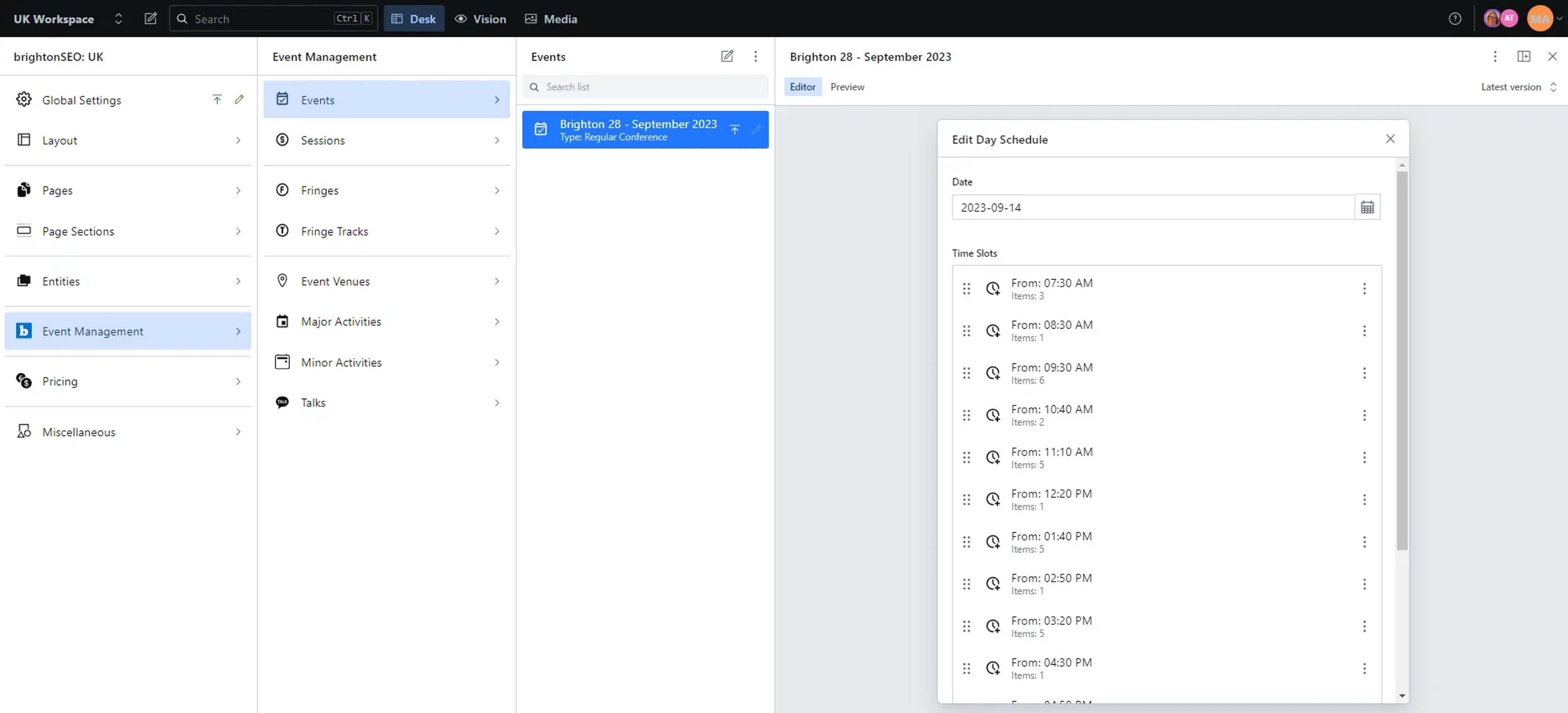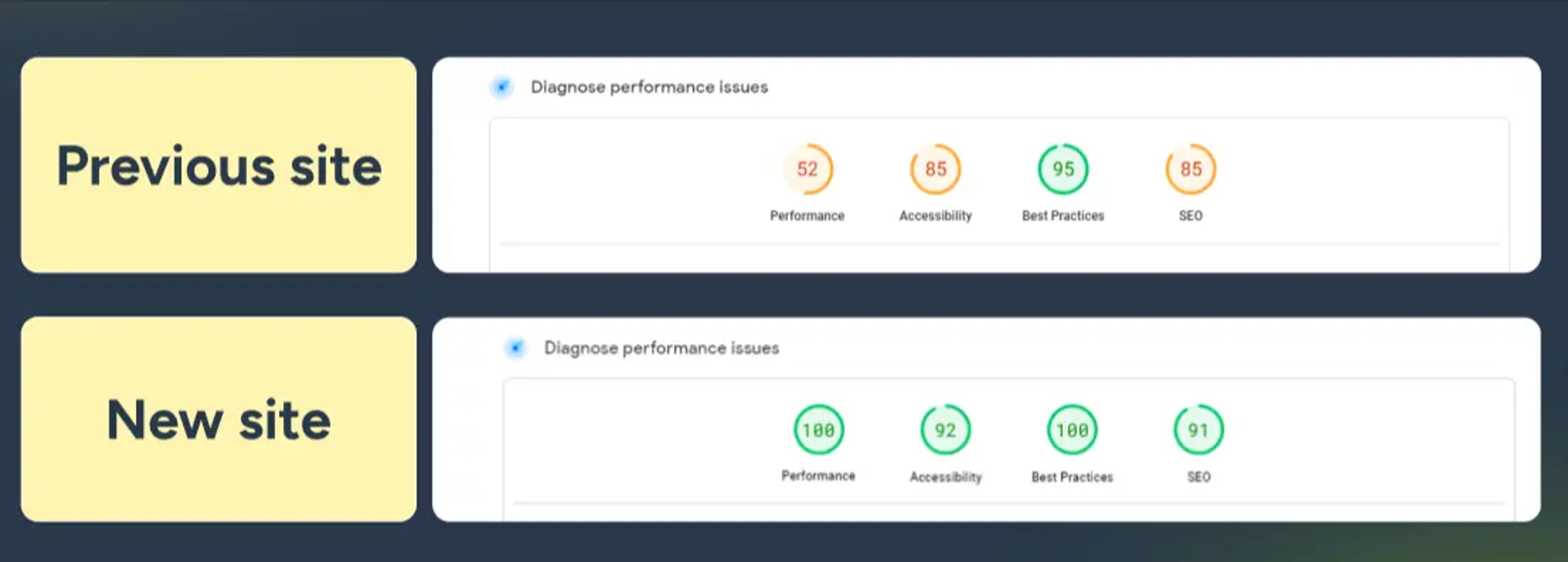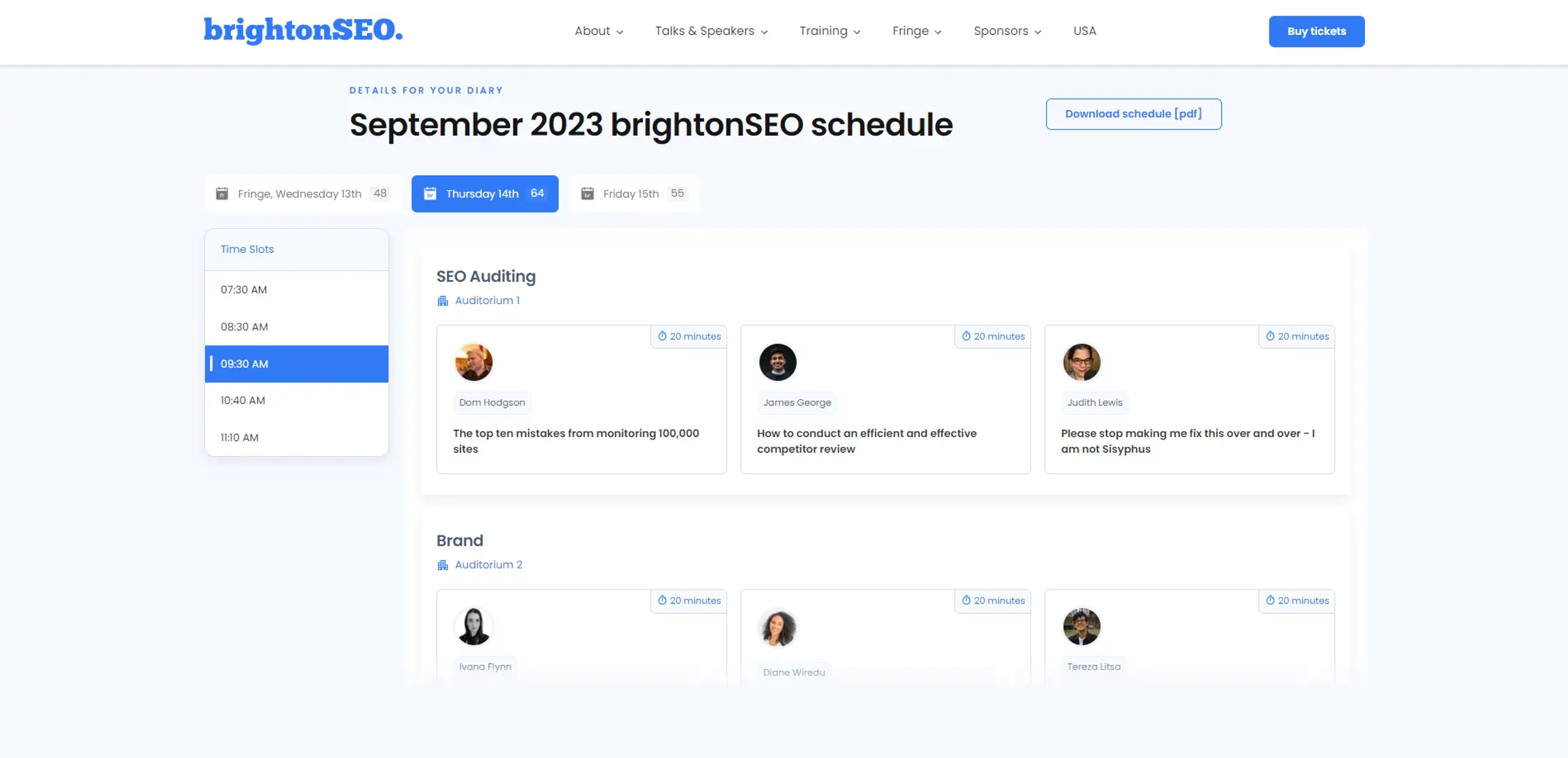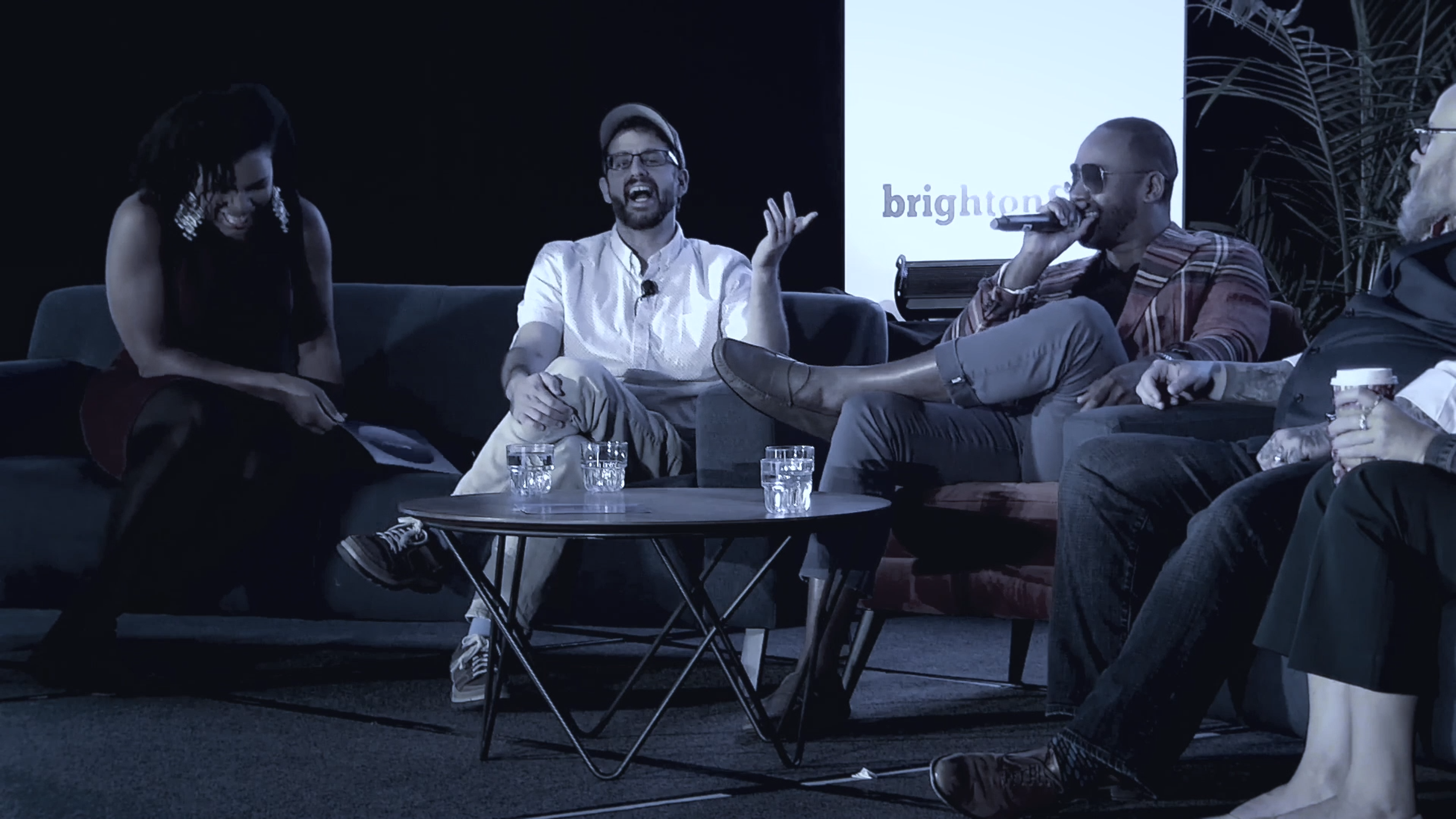Key benefits
- Massive time savings for content teams with streamlined content management experience.
- Significant boost in Core Web Vitals and performance leading to increased SEO, traffic, and awareness
- Content is easy to update, reuse, and make discoverable to engage and grow their community.
We'd outgrown our WordPress setup as our events grew and became more complex. Moving to a modern, future-proof headless solution using Sanity and Next.js means we move much faster with new initiatives. It only took two days to launch a new website for our first US conference!
brightonSEO is the pre-eminent conference for digital marketers from across the world. More than 5,000 attendees flock to its three-day conference held twice a year in the UK, and now the US too. In 2023 the team launched their first event in the US. Founded by SEO expert and UK Search Awards winner Kelvin Newman, the conference consistently sells out and attracts the biggest names in marketing as speakers.
The conference wanted to capitalize on the popularity of its digital brand with a more robust website to provide greater content reuse and better experiences for speakers and attendees alike. After finding themselves blocked by the limits of WordPress, they went on the hunt for a new content system.
About the customer
brightonSEO is the largest SEO conference in the world, with over 5,000 attendees to its 3-day events and an active community who stream content, access training and coursework, and network with other industry professionals.
Sanity partner Lemon Hive comes in to build the new stack
brightonSEO partnered with Lemon Hive, a leading global web and software solutions company specializing in headless architectures, to build their new website. An early believer in composable content infrastructure, Lemon Hive founder Stuart Tofts started the company in 2020 to help organizations capitalize on the benefits of decoupling content from front-end presentation. For brightonSEO’s needs, Sanity emerged as the clear winner for Tofts.
“Sanity, with Next.js, gave us the functionality and features we needed to achieve brightonSEO’s grand plans. We now have this great composable system to do amazing things with content,” says Tofts. “The page speed, overall user experience, and other Core Web Vitals factors with WordPress were subpar. We knew going composable with Sanity would allow us to significantly improve performance on all fronts by decoupling the front end.”
Leaving WordPress for Sanity and Next.js = more speed, flexibility, and security
brightonSEO's WordPress deployment had a number of problems that Lemon Hive wanted to address. The development team disliked working in WordPress as they often had to hack the monolithic CMS to manage multiple events each year.
brightonSEO's performance on Core Web Vitals was also disappointingly low. The site was slow (particularly during the in-person conference), there were no search capabilities to help conference-goers find relevant content, and limited ability to add in SEO-supporting elements like self-referencing canonicals to ensure multiple versions of a page don’t get indexed separately. Although plugins could be used to add functionality to WordPress, each adds weight to the front end and all lack the bespoke features you can build with Sanity.
“Many SEO professionals don’t realize how much they’re missing out on by using WordPress instead of a composable system like Sanity,” observes Tofts. “You take a performance hit with WordPress, and you can’t leverage a lot of the new content modeling tools that make content more SEO-friendly and performant for rankings. You also miss out on the ability to automate tasks such as schema markup”
Security was a concern as well, due to WordPress's convoluted plugin ecosystem. Because a standard WordPress install relies on a large number of third-party plugins to get to a standard feature set, staying on top of critical updates and changes to WordPress Core was a significant burden for brightonSEO’s busy team—and stakes were high as missing an update could lead to devastating security hacks.
According to Tofts, "If you lose customer data in the UK, the potential fines are significant. The fallout in the US is similar. And it can easily happen when you wait too long on just one update."
With Sanity, Lemon Hive can fully customize brightonSEO’s editing experience, creating intuitive workflows based on the team’s unique content types and content management tasks. Having a workspace tailored to their goals and workflows empowers brightonSEO’s content team to make changes to the site independently. This includes standard page updates as well as interactive content like the new Schedule content type, which requires frequent updates to reflect changes across dates and times, locations, speakers, and talk topics.

“The amount of customization we can do with Sanity is amazing. With WordPress, it was always ‘no we can’t, no we can’t.’ Now we’re saying ‘yes we can!’” says Tofts.
brightonSEO’s user experience (including Core Web Vitals factors) has improved significantly since launching the new website. In terms of security, Sanity brings a significant reduction in dependencies on updates as it is reliant on API calls instead of a monolithic system. There’s also less risk with plugins as they’re open source (making the code inspectable) and they run client-side which means they’re limited to a logged-in Sanity user’s level of access.

Content reuse increases efficiency, SEO, and UX
With their new site, past conferences will be available so visitors can more easily access the plethora of prior talks and speaker information. With Sanity, brightonSEO introduced a new, more flexible structured content model for fields like Speakers, Trainers, Talks, and Courses to organize all conference information and drive greater reuse it in whatever page format they desire.
Because speakers, talks, and events are treated as entities on Sanity, brightonSEO can improve visibility for searches of these entities and related questions around SEO and digital marketing topics. This is expected to grow traffic significantly, improve brightonSEO’s search ranking, and increase awareness.
Pain points of the prior implementation weren’t limited to post-event experiences, of course. The brightonSEO team had stopped publishing an interactive schedule in 2021 when they went to a multi-day event—with the prior content system it had become prohibitively time-consuming to produce and difficult to manage.
For upcoming conferences, Sanity enables them to leverage the My Schedule feature, which links directly back to talk and speaker information, making it both insightful for attendees and referenceable for on-demand exploration. This is powerful as many topics are relevant to brightonSEO’s community of 40,000 digital marketing professionals long after each conference ends.

New revenue streams become possible with Sanity
brightonSEO is using its reputation as the premier search marketing conference to create a more holistic ecosystem of digital properties for its community. In doing so, brightonSEO is delivering value for its community—and optimizing revenue streams beyond the brightonSEO event.
These revenue streams include new conference locations, more sponsorship models, additional fringe events, training courses, and paid on-demand content, which together make the business more resilient against outside market factors like the COVID-19 pandemic. By centralizing content management with Sanity, brightonSEO is able to move towards this vision more efficiently.
Going forward, the company sees many opportunities to enhance community and attendee experiences and drive repeat attendance with Sanity as their composable content solution, including:
- Adding a custom mobile app to engage conference attendees on the ground. "It would be a relatively low lift since the underlying content is already built in the back-end," shares Tofts.
- Building a system for sponsors to purchase stand space directly from the website
- Selling video-on-demand packages directly to the community post-conference (rather than through a third party).
“There’s so much Sanity lets us do. As just one example, if brightonSEO wants to take the live content coming out of the event and push it to the in-conference displays, all we need to do is create a new front-end in Sanity,” says Tofts. “The possibilities are endless, and the new site is only the start of the journey.”
In the end, the new brightonSEO website Lemon Hive built using Sanity saves the brightonSEO team significant time and gives them autonomy to easily manage the website (without relying on the developer team at Lemon Hive to handcraft every request). This translates to better experiences for their community and sustained revenue streams to ensure they continue to deliver value over the long term.
Unlock the potential of headless SEO
Sanity is the SEO-friendly composable content platform you’ve been dreaming of. With all the features of a top-tier headless CMS, Sanity goes beyond simple content management enabling you to scale your SEO strategy beyond your website and into the next generation of omnichannel search.







